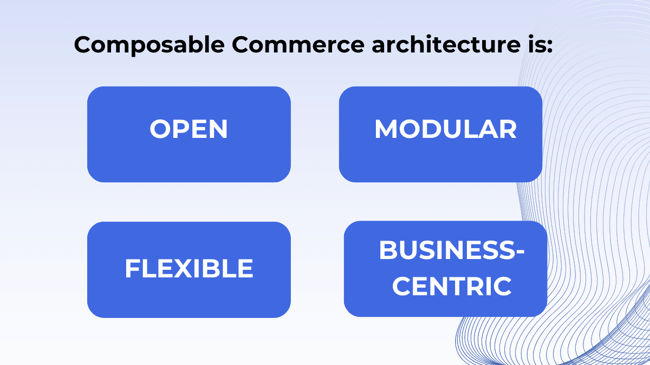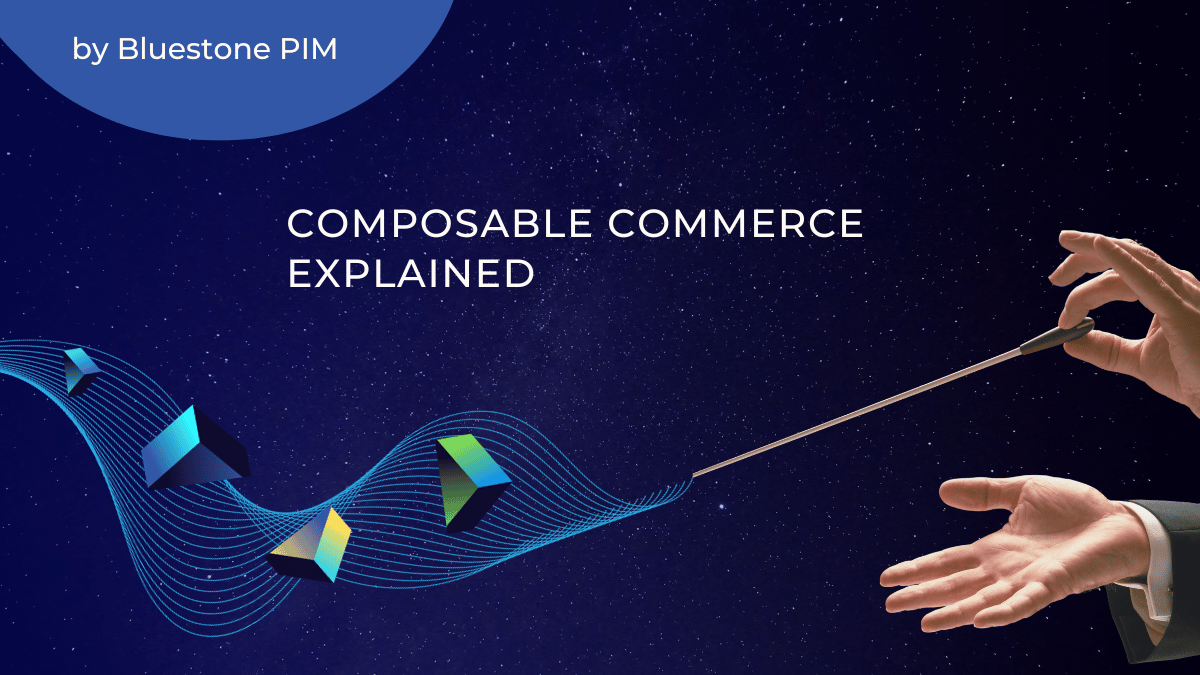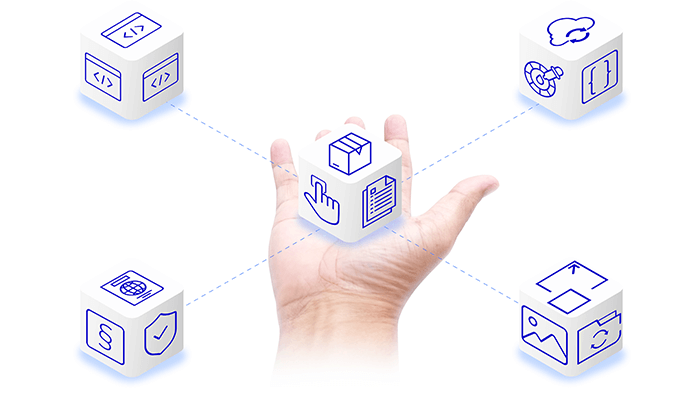Why Companies Are Replatforming Towards a More Composable IT Architecture

The retail and manufacturing landscapes are currently engaged in a digital arms race. Consumers demand flawless omnichannel experiences, while supply chains require chameleon-like agility to adapt to ever-changing realities. Many companies find themselves burdened with outdated solutions and the mounting technical debt of legacy monolithic IT architectures. Once popular, these systems are increasingly seen as clunky dinosaurs in an era of rapid technological advancement.
This is where the need for replatforming comes into play. In this article, we will explore the foundational aspects of replatforming, discuss how to approach it, highlight some common pitfalls to avoid, and consider the emerging paradigm of composable commerce architecture. We will also examine the numerous benefits this modern approach can bring to companies seeking software that better fits their needs and strategies.
What is Replatforming?
Software replatforming is the process of migrating applications and systems from one platform to another, typically to modernize outdated infrastructure and leverage new technologies.
For large retail and manufacturing enterprises, as well as the broader digital commerce sector, replatforming can be a significant and costly undertaking. However, it is a crucial strategy for enhancing large-scale operational efficiency, gaining a competitive edge in sales and marketing initiatives like omnichannel marketing, and swiftly adapting to the ever-evolving demands of consumers.
When Is It Time to Replatform?
Organizations may find themselves compelled to undertake legacy application replatforming, aiming to replace digital legacy systems, due to various triggers. Some common triggers include:
-
Technological obsolescence – old systems become obsolete over time, unable to support modern software applications or integrate with newer technologies.
-
Scalability issues and inflexibility – legacy systems often struggle to scale to meet increasing demands, whether in terms of user volume, data processing, or transaction capacity. In addition, these systems are typically monolithic in nature, making them rigid and difficult to customize or adapt to changing business needs.
-
Security vulnerabilities – lack of robust security features and protocols necessary to defend against modern cyber threats.
-
Poor user experience – current system hinders both internal users and external customers. Employees may find them cumbersome and slow, reducing productivity. Customers may experience inefficient interfaces and slow response times, leading to frustration and a negative perception of the company.
If your organization is struggling with those issues, it is time to seriously consider undertaking legacy application replatforming and modernizing your digital infrastructure.
How Replatforming Works: The 7 Key Steps You Need to Know
Let's explore a sample outline of the typical and fundamental steps involved in executing a replatforming process from inception to completion. This can serve as a checklist of essential actions to ensure a smooth and successful transition.
-
Assessment and goal definition – begin by conducting an in-depth evaluation of your current IT infrastructure and systems. Identify the pain points, limitations, and goals driving the replatforming initiative. Define also success criteria for the replatforming project.
-
Platform evaluation and selection – research and evaluate potential platforms that align with your goals and requirements. Consider factors such as software architecture, scalability, performance, security, compatibility, and vendor support. Create a shortlist of viable options and conduct in-depth assessments to determine the best fit for your organization.
-
Risk analysis and mitigation – identify potential risks and challenges associated with replatforming, such as data loss, downtime, integration issues, and resource constraints. Prepare a risk mitigation plan outlining strategies for minimizing and addressing these risks throughout the project lifecycle.
-
Resource allocation and planning – determine the resources needed for the replatforming project, including personnel, budget, and technology. Write a project plan with timelines, milestones, and dependencies. Delegate tasks to team members and secure sufficient support from stakeholders.
-
Data migration strategy – develop a comprehensive strategy for migrating data from the legacy platform to the new one. Consider factors such as data complexity and volume. Plan for data validation and testing to ensure a smooth transition with minimal disruptions. Assess the existing applications and systems to determine if any adjustments are needed to align with the new platform architecture. Prioritize changes based on business impact and feasibility.
-
Testing and deployment – establish testing protocols and procedures to validate the functionality, performance, and security of the replatformed environment. Conduct thorough testing at each stage of the project. Execute the rollout plan in stages to minimize disruption and coordinate activities to ensure a seamless transition from the old to the new platform. Monitor system performance and user feedback during the implementation process.
-
Post-implementation review – conduct a post-implementation review to evaluate the success of the replatforming project against the defined objectives and success criteria. Identify areas for improvement, and optimization opportunities. Implement improvement initiatives to optimize the performance and efficiency of the new platform.
-
Documentation and knowledge transfer – document the replatforming process, including procedures, configurations, and best practices. Provide training and knowledge transfer sessions to relevant stakeholders to ensure they are equipped to effectively operate and maintain the new platform.
Issues to Be Aware of Before Replatforming
Before companies embark on a replatforming initiative, they need to be aware of the potential challenges in order to avoid mistakes. Here are some important points to consider:
-
Insufficient planning – a rushed transition without a clearly defined plan can lead to costly mistakes. Companies should invest time in comprehensive planning
-
Lack of alignment with stakeholders – the transition may impact various stakeholders across the organization, including IT teams, business units and senior management. To avoid resistance and maximize support throughout the process, it's important that all stakeholders are aligned.
-
Underestimating complexity and risks – replatforming can be a complex endeavor and organizations need to anticipate the difficulties involved and allocate sufficient resources, expertise and time to manage the process successfully. Data migration is often one of the most difficult aspects of the transition. Companies need to assess the compatibility, integrity and security of the data to minimize the risks.
-
Integration challenge – integrating the new platform with existing third-party systems and services can be a major challenge. It's important to develop a solid integration strategy to ensure a seamless connection and smooth data flow within the ecosystem.
By proactively addressing these issues, companies can minimize risk and increase the likelihood of a successful replatforming initiative.
Consider Going Composable When Replatforming
If you want to move from a monolithic legacy system to modern, more flexible solutions, you should consider composable commerce and composable architecture. These represent a new paradigm for building e-commerce and IT ecosystems, overcoming the limitations of the monolithic and all-in-one suites approaches.
Monolithic systems, characterized by their large, tightly integrated structures, often hinder adaptability to changing business needs and technological advances. Many retailers and manufacturers currently rely on traditional and best-of-suites solutions from large vendors such as SAP, Oracle, Adobe, Salesforce and IBM. While these solutions offer comprehensive packages, they are often associated with high prices, complex implementations and an overwhelming lack of flexibility.
In contrast, composable commerce and architecture embrace modularity, flexibility as core principles. For those considering a replatforming strategy with modern cloud and API-first technology, the composable approach offers a compelling solution. By deconstructing systems into smaller, reusable components, also referred to as Packaged Business Capabilities (PBC), organizations can create bespoke solutions tailored to their unique requirements. This modular approach facilitates faster innovation, seamless scalability, and optimized resource utilization compared to monolithic architectures.
In essence, envision such an IT ecosystem as constructed with interchangeable building blocks, each representing a specific function like a headless commerce system or an inventory management platform. These independent modules can be interchanged, integrated, and scaled to meet the dynamic needs of the business.
The increasing popularity of composable commerce and architecture arises from the rising need for flexibility and agility in today's digital environment. The composable approach equips businesses with the necessary tools to navigate and succeed in this fast-paced landscape. This includes features such as API-first design, headless capabilities, cloud deployment, and scalability.
Overview of Key Benefits of Composable Architecture
-
Enhanced agility and flexibility – allows you to quickly respond to changing business needs by swiftly integrating new services, features and capabilities. This modular approach enables you to deploy and modify individual components without disrupting the entire system, fostering a more responsive and adaptable IT environment.
-
Vendor independence – provides the freedom to choose and integrate components from various vendors, avoiding the limitations of being locked into a single vendor's ecosystem. You can select best-of-breed solutions that meet your specific needs, enhancing the overall quality and performance of your IT infrastructure.
-
Exceptional scalability – enables you to expand or contract IT resources based on your needs, handling increased workloads or adapting to changing demands without significant overhauls. This efficient scaling optimizes resource utilization, reduces costs, and maintains high performance, ensuring your business remains agile and responsive.
-
Lower Total Cost of Ownership (TCO) – optimize the cost of your solution by focusing on acquiring the features and capabilities you need rather than purchasing an all-in-one suite with various unnecessary functionalities. Additionally, with multi-tenant SaaS and cloud deployment, you reduce the costs associated with on-premise or single-tenant SaaS solutions, as well as the costs of maintenance and updates.

What Can You Achieve by Replatforming to Composable Commerce Solutions?
By embracing a composable approach, businesses across industries can enjoy numerous advantages that directly impact their bottom line and enhance competitiveness in the following ways:
-
Enhanced product experience – enables businesses to deliver seamless and intuitive product experiences by integrating various systems and data sources. This fosters customer satisfaction and loyalty through accurate product information and personalized recommendations.
-
Streamlined product data flow – ensures seamless data exchange across multiple systems and channels, avoiding data silos and discrepancies. This enhances decision-making and operational efficiency.
-
Personalized customer journey – companies can create omnichannel and personalized customer journeys across multiple touchpoints and channels. By leveraging omnichannel consistency, data synchronization features, and real-time data, businesses can tailor experiences to individual preferences, boosting engagement and conversion rates.
-
Faster Time-to-Market – allows companies to introduce new products and features more quickly and efficiently. By leveraging modular components and pre-built integrations, businesses can innovate without extensive custom development, staying ahead of competitors.
-
Increased sales and revenue – drives sales and revenue growth by delivering superior product experiences, optimizing data flow, and enhancing the customer journey. This can bring higher conversion rates, repeat purchases, and increased customer lifetime value.
Composable commerce revolutionizes retail and manufacturing, offering significant benefits for businesses. In retail, imagine a seamless integration where the point-of-sale system connects effortlessly with inventory management and ERP system. This integration ensures a unified customer experience, enabling real-time stock tracking and personalized marketing campaigns tailored to individual preferences.
Replatforming and moving into a composable architecture can help deliver agility, lower TCO and faster time to market. By working with best-of-breed technologies and taking a modular approach, your business can have more flexibility when building applications and deliver them at greater scale.

Tal Ofer
Head of Growth Council at Mach Alliance / Partnerships Director at Cloudinary
Begin Your Replatforming Journey to Composable Systems by Prioritizing Your Product Information
In the realm of composable commerce, whether you opt for a major overhaul in a short amount of time or adopt a phased approach, starting the replatforming journey with your product information as the foundational element for the entire IT ecosystem and customer-facing channels is paramount.
This approach requires a composable Product Information Management (PIM) system, such as Bluestone PIM, to serve as the source of truth for product information distribution across various channels.
By establishing a composable PIM as the central hub, you ensure consistency and accuracy in data management, facilitating seamless collaboration among teams and partners. This foundational step lays the groundwork for efficient data syndication, enabling rapid adaptation to market changes and enhancing the overall agility and responsiveness of your commerce solution.
Transitioning from legacy systems to composable architecture empowers businesses with the flexibility and agility necessary to meet ever-moving market demands. By prioritizing a composable PIM system as the foundation, companies can ensure accurate product information distribution and seamless integration across channels, setting the stage for sustained growth and innovation.
Morten Næss
Mach Alliance Admissions Lead / EVP of Technology at Bluestone PIM
3 Essential Steps Before Migrating to a Composable Platform
1. Assess Your Infrastructure and Replatforming Readiness
Evaluate your current technology infrastructure to determine its readiness for composable commerce, focusing on factors such as modularity, scalability, and compatibility with composable solutions.
Identify potential risks and challenges associated with replatforming to composable technology, such as data security, compatibility, and the risk of disruptions to business operations, and develop strategies to mitigate them effectively. Evaluate the integration capabilities of composable commerce solutions to seamlessly connect with existing systems, applications, and third-party services across your ecosystem. Assess the quality, consistency, and accessibility of your data to ensure it can support real-time synchronization and personalized customer experiences within a composable architecture.
One of the benefits of composable commerce technology is that it does not necessarily entail replacing all existing software or pose a risk of disrupting current operations. Companies have the flexibility to retain currently essential systems like their legacy ERP while gradually transitioning to a composable architecture. For instance, they can start by implementing a Product Information Management (PIM) system to centralize and enhance product content for customer-facing channels. Next, they can gradually add new integrations or services, such as CMS or OMS.
By taking a phased approach, companies can build upon their existing infrastructure, adding new software components as they become ready. This incremental approach allows organizations to minimize disruption, mitigate risk, and adapt their technology stack to evolving business needs effectively.
2. Identify the Necessary Expertise, Whether From Within Your Organization or Externally
If your company lacks expertise in composable commerce or the necessary in-house capabilities, partnering with system integration services specialized in composable commerce can be a strategic decision.
Composable commerce is a complex undertaking that requires specialized knowledge and skills to be implemented effectively and efficiently. These experienced partners bring a wealth of expertise in designing, implementing, and optimizing composable commerce solutions, ensuring that the transition to a composable architecture is done right. By leveraging their specialized knowledge, companies can navigate the complexities of replatforming with confidence, minimizing risks and maximizing the benefits of composable commerce.
System integration partners can provide valuable guidance throughout the process, from assessing your current infrastructure to designing and implementing tailored, composable solutions that meet your specific business requirements. Additionally, these partners can offer ongoing support and maintenance of your composable commerce initiatives.
Collaborating with a trusted system integration partner enables companies to accelerate their journey towards composable commerce, drive innovation, and stay competitive in today's digital landscape.
3. Secure Stakeholder Buy-in and Business Alignment
Composable commerce may represent a new paradigm for your company. To facilitate its adoption, gain support from key stakeholders, including executives, IT leaders, and department heads. Secure the necessary resources and investments by clearly communicating the benefits of composable commerce, emphasizing not only its technological advantages but also the business value it brings.
Align your replatforming goals with your business objectives, highlighting the agility, flexibility, and innovation that composable technology enables. Additionally, assess how composable technology can scale and adapt to evolving business needs, such as changes in demand, shifts in market dynamics, and the emergence of new technologies.
Take a Step Into Your Replatforming Journey
The shift towards composable architectures is a pivotal moment for retail and manufacturing businesses. By embracing a modular approach, companies can unlock a new era of agility, lower costs, and establish a foundation for continued growth in the ever-evolving digital landscape. This composable future allows businesses to build their IT ecosystem, not be bound by it.
If you're ready to embark on your composable journey and have questions about Composable Commerce and PIM, reach out to our PIM advisors today. Schedule a free consultation or book a demo meeting to explore the possibilities of Bluestone PIM, the leading composable PIM solution.





